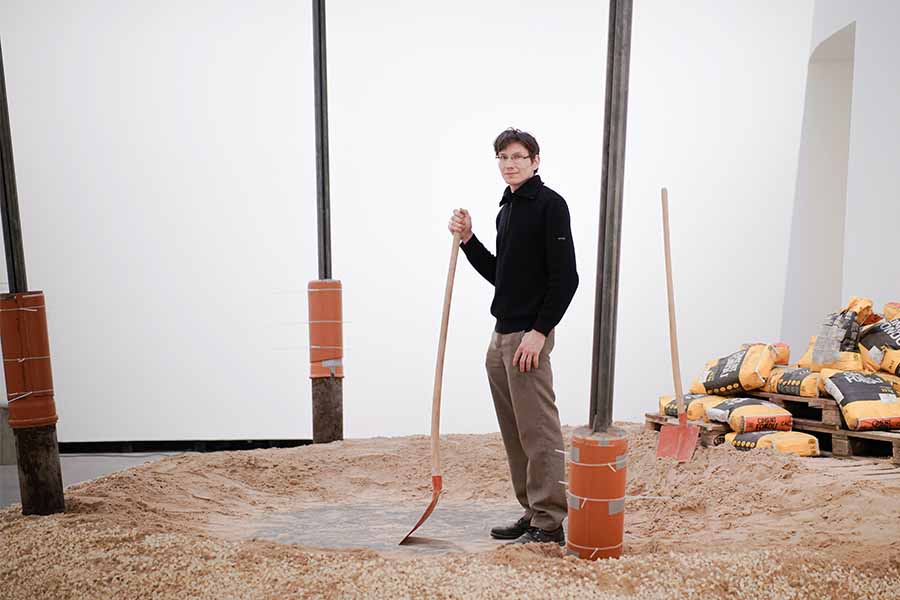5 Questions to Adrien Tirtiaux
Throughout the year the Belgian artist, Adrien Tirtiaux, runs the “Island at Marta” as a work of art and working space in the midst of the exhibition. Here the visitors are encouraged to become active themselves and learn to literally “grasp” the respective exhibition theme. The design of the room is changed in accordance with the respective exhibition theme. In this interview, the artist talks about the chances and difficulties presented by this concept.
Your work is highly influenced by your training as an architect. You create not only room installations, but also engage intensively with the buildings and places. What does the encounter with this Marta building by Frank Gehry mean to you, being already familiar with it from the Marta exhibition “Revolution in Red-Yellow-Blue”?
I’m not particularly a Gehry fan, but Marta is really an experience: it is super exuberant and quite well integrated in its context at the same time. If you have the chance to go behind the scenes and see the structural construction between the inner shell and the outer shell, you realize how crazy and consequently it is built until the smallest details. When I was invited for “Revolution in Red-Yellow-Blue” in 2017, I was very excited! My ideas mostly come in reaction to the spaces I’m invited to work in, and it is always very inspiring when the space has some character. Half of the job is already done: I “just” have to look for a way how to intervene and how to enhance the existing features of the space, and how to give them another or an additional reading. At Marta, both my installations for the Rietveld-show and the island came from the huge skylights, which are very generous spaces but too high to reach, so they are not exploited in most exhibitions. Working vertically and going up there is a real physical encounter with the building, trying to enter in dialog with its solemnity instead of being subjected to it.
For the “Island at Marta” you have to work not only within the framework of one, but in three successive exhibitions for which the room has to be redesigned each time. Is it particularly appealing to work on such a long-term basis?
It is a very nice invitation indeed. There is a strong narrative component in my work, as my publications (which look like Tintin albums) clearly witness. I conceive my installations with a certain dramaturgy, in different spatial sequences that will be encountered by the visitor one after the other. Sculptures usually result from a particular building process, which sometimes even make the object of a comic story. The “Island at Marta” is the occasion to create a broad narrative, with different components that will change meaning or function over the course of one exhibition, and then again for the next exhibition, with a new context given by another topic. I see it like a story in three chapters, or a theater play in three acts. In each chapter, the protagonists go through a series of transformations with the help of the public, making the narrative and the space always more complex.
For the first phase, the theme was “Glass and Concrete” – typical construction materials that you would be familiar with. But what about photography and painting – is this new territory for you? How have you approached the theme of “Deceptive Images”
I am familiar with concrete but I work with it like a dilettante, trying out things with various formworks or compositions. Making concrete is really not complicated, so I proposed the visitors of the exhibition to take a shovel and pour the palm trees of the island themselves, within the workshops. I approached “Deceptive Images” from the same DIY side… Photorealistic painting can be very impressive, but the technique itself is pretty easy: you project a photographic image on your support, and then it is a bit like “painting by numbers”. Even painters like Vermeer seem to have used the Camera Obscura for their compositions. Therefore, we’ll see where this technique leads us – me and the public, which will be invited to draw onto projected images on the walls of Marta.
The “Island at Marta” has a special function as an educational space in which the contents of the exhibition are communicated and further examined. Was it easy for you to work with this concept?
In a way I work like an architect: I’m given a space, a topic and a budget, and according to these parameters I develop an intervention proposal, which will get more and more precise in dialog with the client. When there is also a function to fulfill, it is just another parameter to integrate. Some architects even like it when there are a lot of constraints! For the “Island at Marta”, I worked in close collaboration with the educational team of Marta, which gave me a list of ideas – things that could be shown or activities that could be proposed to the public. I developed some of these ideas, ignored a lot… and proposed others, for example that the public could really be involved in the transformation of the space and of my installation. It is a way to make the visitor aware of his/ her responsibilities, instead of only proposing a program.
Stranded on a desert island – what could you not do without?
It’s hard to imagine life without internet, chocolate and cigarettes, but I guess I would get used to it. I like solitude and I guess I would probably enjoy it for a while, trying to feed myself and build a palace with what I find, like in survival videos on YouTube… Maybe just leave me a Swiss knife to start!


